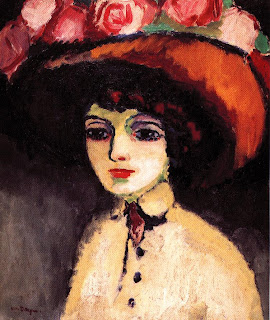Did anyone in the art world suspect that the 14 paintings were fakes? In the early 1990s the canvases were presented for sale to an auction house in Germany. The first warning that something may have been amiss didn’t come until 2008, when a George Grosz expert questioned the authenticity of the Gallery Fechtheim labels on the picture-backs. Two years later, word of possible forgeries had leaked out and the Berlin state criminal police started an investigation. Only now, in 2011, has 60 year old Wolfgang Beltracchi become the first of the four people accused of fraud to admit to the charges.
Campendonk, Man Horse Cow, c1918, 64 x 77 cm, private collection. Legitimate
The cost so far: €16 million in forgeries, resulting in total damages of €27 million. The list of fakes included works apparently by Max Pechstein, Heinrich Campendonk, Max Ernst, André Derain, Kees van Dongen and Fernand Léger. If I was designing a course for students on Expressionist artists, I could not have selected a better group of artists myself.
Rich investors were tricked into buying what were claimed to be long-lost paintings by these German and Dutch artists of the early 20th century. According to the story given to the auction house, the paintings had belonged to a rather secretive collector, Werner Jaegers. Werner who?
Jaegers was said to have been a client of Alfred Flechtheim (1878-1937), the famous Jewish gallery owner whose business really WAS seized by the Nazis. Jaegers' granddaughters said he had bought this degenerate art from Flechtheim and had to hide it in the mountains near Cologne. Jaegers, according to the granddaughters' story, feared Nazi art-confiscators might discover his stash and take the offending pictures away. This was the reason, the women said, why the paintings were totally unknown by the modern art world.
Wolfgang Beltracchi, who had once been a student in an art school, had learned to copy art from his father, an art restorer who did replicas of the Old Masters. Beltracchi said he began copying on a professional basis in the 1970s, not because he liked the art market, the greedy dealers or the greedy buyers, but because he loved doing the paintings.
Why did Beltracchi choose to copy lesser known WW1 era expressionists and not, for example, Cezanne or van Gogh where he could have made more money per fake? I am assuming because a mother lode of previously unknown Cezannes and van Goghs would have provoked amazement in the art world, and therefore close scrutiny. WW1 expressionist works were less well known, more scarce and their prices were rising at a slow but acceptable pace. All that was missing was an adequate supply of new works, which Beltracchi and his team provided.
Campendonk, Landscape with Horses, 1915. Faked by Beltracchi
Judge Wilhelm Kremer said it was amazing that art collectors had not noticed the deception about the supposed collector, Werner Jaegers, who was in reality the grandfather of Wolfgang Beltracchi's wife and co-defendant. “Jaegers was supposed to have collected Rhineland expressionist artists from the age of 16 or 17”, said Judge Kremer incredulously. As it turned out Jaegers, who died decades ago, did not collect art at all.
My feeling is that Judge Kremer was overly optimistic. I probably know a little bit more about the pre and post-WW1 German Expressionists than the average person on the street, yet there is no way I would have picked up their fake status via inspection. Furthermore I most certainly would not have checked the provenance of a painting, IF the auction was being run by a reputable firm.
And examining the estimated prices for bargains that were too-good-to-be-true would not have been helpful either. In the biggest fake sale, Red Picture with Horses, supposedly painted by Heinrich Campendonk (1888-1957), sold at auction in Cologne for $A3.4 million. It was the highest price ever paid for work believed to be by the Rhineland expressionist - not a bargain at all!
According to German news magazine Der Spiegel, a famous American film star bought one of the forgeries in 2004, believing it to be a 1915 work called Landscape with Horses by Campendonk. If the film star’s expert art advisors didn’t pick the fake, there is no way that an ordinary art lover could have known.
In thinking in particular about Heinrich Campendonk, I would have been personally quite pleased to “rescue” one of his works. A German artist, he had been a member of the famous Der Blaue Reiter group in the years just before WW1 erupted in 1914. When the Nazis came to power in 1933, he was among the many modernists labelled as degenerate artists, his paintings were removed from German galleries and his career prospects were slim. He emigrated to the Netherlands where he spent the rest of his life working at the Rijksakademie in Amsterdam.
van Dongen, La parisienne de Montmartre, 1911, 65x 54cm, Le Havre, Musée des Beaux-arts André Malraux. Legitimate
I would have liked a Kees Van Dongen (1877-1968) as well. This Dutch artist began to exhibit in Paris, and participated in the controversial 1905 exhibition Salon d'Automne, along with the other artists who created the bright colours beloved by the Fauves. He was also a member of the German Expressionist group Die Brücke for a time. van Dongen's portraits of well dressed women with beautiful hats and jewellery were a delight.
van Dongen, Portrait of Woman in a Hat. Faked by Beltracchi
Like artnet, I would want to know how an art fraud of such magnitude could be so successful? How did all the control mechanisms in the art market fail so comprehensively? Clearly the supporting documentation was of no assistance since the collection’s authenticity was "confirmed" by fake documents and fake photographs.




